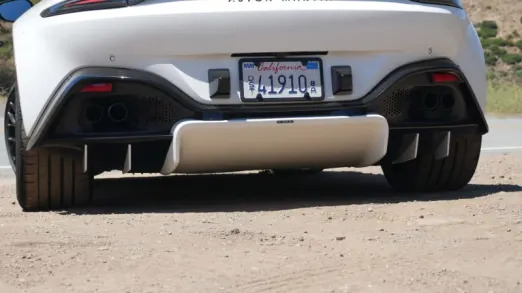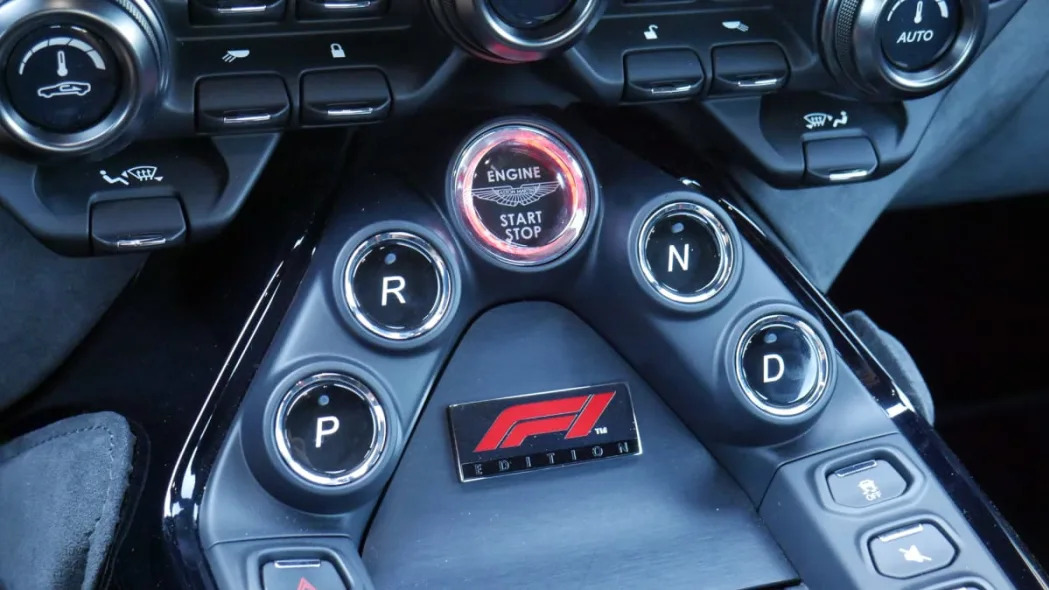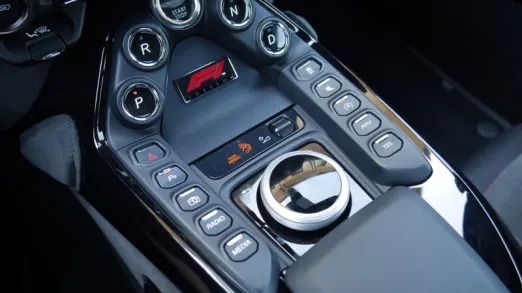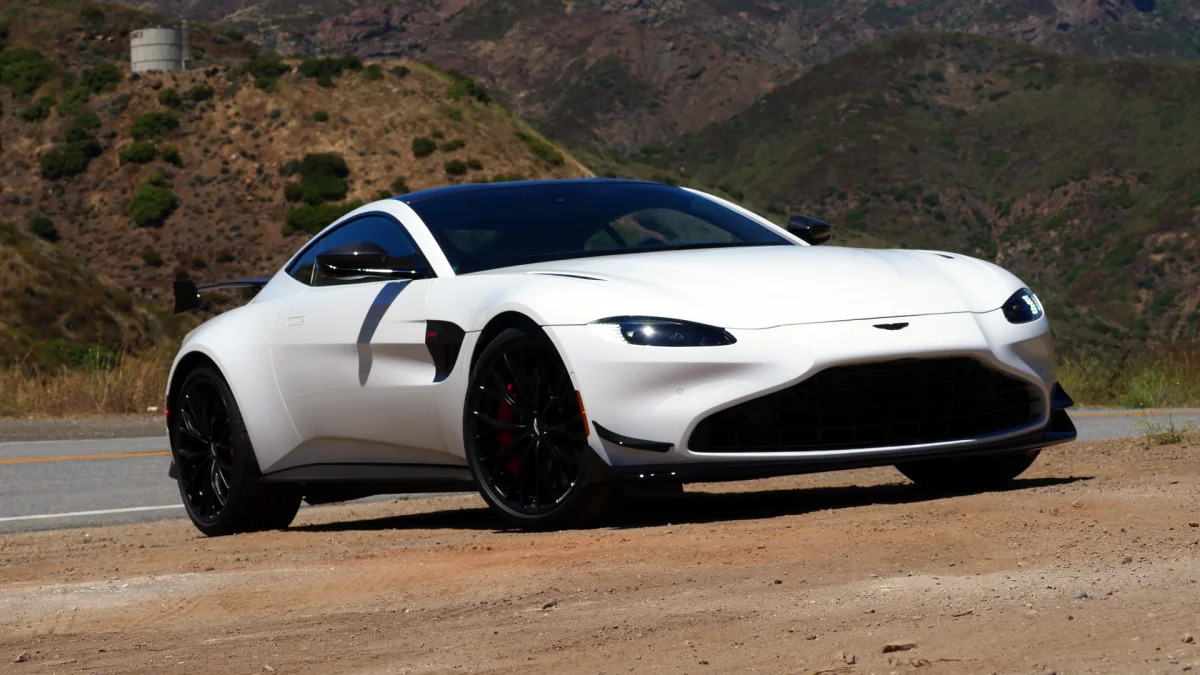AGOURA HILLS, Calif. – As if driving an Aston Martin Vantage isn’t special enough, this would be the F1 Edition, which isn’t just a special paint job and some stickers commemorating Aston’s return to Formula 1 back in 2021. It’s effectively a replica of the Formula 1 safety car, which itself isn’t just a special paint job and some stickers. The powertrain, chassis and aerodynamics are all upgraded to meet the increased demands of the job, upgrades that were transferred to the car you see here.
The AMG-sourced 4.0-liter twin-turbo V8 gets an extra 25 horsepower for a grand total of 535. Maximum torque output remains the same at 505 pound-feet, but that peak is sustained longer. The eight-speed automatic’s shift times are decreased and its responses while braking are improved. As for the chassis, the underbody is strengthened, the dampers are reworked for improved vertical body control, and the rear spring rates are increased. The steering is altered for improved feedback as well, and the wheels are enlarged to 21 inches, up from the standard car’s 20.
Finally, it looks different due to the aerodynamic enhancements: full-width front splitter, front dive planes, underbody turning vanes, and just in case you didn’t notice it, a wing. Surprisingly, the big rear diffuser actually carries over unchanged. Also surprisingly, you can get the Vantage F1 Edition as a convertible, but as it was created to pace F1 and not the Indianapolis 500, opting for the Coupe results in the most faithful replica.
Unfortunately, I have never driven any other current-generation Aston Martin Vantage, so how much of a difference any of the above does is a mystery to me. I suspect the ride is worse given what I’ve read about the Vantage’s grand-touring capabilities, but I doubt you’re really trying to decide whether to check the F1 Edition option box, so here are the things that most stood out to me while driving the Aston Martin Vantage F1 Edition.


1. Oh man, the noise! Part I
Words can’t really do justice to how incredible this car sounds when you lay into it, and believe me, there’s something about driving an Aston Martin that makes you want to lay into it. And fire guns out of the headlights, but that’s a different story. There’s the rumbling wail from the exhaust. There’s the whirring V8, which definitely has a different tone than the AMG versions of the 4.0-liter twin-turbo V8, but it’s still clearly related. The Porsche 911 sounds brilliant, but this is better. Hooray V8s.
2. Oh man, the noise! Part II
On the other hand, when you’re just driving around, there is no rumbling wail. It’s more like a deep concussive whir around 2,000 rpm. It gets old. Also, in Track mode, the exhaust throws in crackles and pops on the overrun, but they don’t actually sound all that good. Very contrived. I wish I could engage Track mode for the transmission but leave the exhaust in normal. Between this and the wing, this particular Aston Martin doesn’t exactly fit into the admittedly old-school mold of “gentlemen’s motoring” I associate with the brand.

3. I could use a transmission setting between Sport+ and Track
Unlike with a Porsche PDK or Mercedes-AMG transmission, the Aston’s eight-speed torque converter automatic was not able to achieve “just leave it in auto” excellence. Sport+ wasn’t smart enough to downshift as readily and by as many gears as was needed. Track was, but it would then hang onto those gears too long, especially if you lift off the throttle suddenly at higher rpm. This wouldn’t be a problem when serving as a Safety Car given the higher speeds and more prolonged acceleration, which is perhaps the issue – I’d be curious to try a standard Vantage for this area in particular.
4. Built for the track, impeccable on a mountain road
This is a front-engined, rear-wheel-drive car, but it’s also a remarkably balanced sports car that stays as planted as promised by its F1-specific upgrades. On Mulholland Highway through the Santa Monica mountains, it flat-out hauled. Feel through the chassis and steering is abundant; the grip prodigious. This is an easy car to drive quickly. Rewarding, too.
5. The ride lives up to the F1 badge
This is not a comfortable car. Perhaps more so than a Porsche GT3, but even its default Sport mode (there is no Comfort) has the ability to turn perfectly acceptable pavement into a tiresome experience. On Mulholland Highway, I was also only able to use Sport. It just became too bumpy and unsettled in Sport+, which rendered Track mode utterly moot.
Then again, this is an F1 Safety Car replica. Its Track mode should be an honest-to-god track mode. This would be the other area I would most like to compare with a standard version of the car.

6. The steering wheel isn’t actually a wheel
Admittedly, I think this “wheel” is ugly. I initially thought it was silly, but I’m retracting that. The design ends up taking up less real estate, and if you’re like me and shuffle steer, the unusual chunky grips at 4 and 8 combine with the traditional ones at 2 and 10 to basically give you three excellent grip points (the default 3 and 9 being the other). The top and bottom are then flat.
That said, I could live without the suede wheel. Unless you wear driving gloves, which I suppose you would be while driving an F1 Safety Car, it sure seems less grippy to me than leather would be.


7. Ye olde Mercedes tech interface isn’t a bad thing
Despite my expectation, the V8 Vantage does not have the same Mercedes-sourced infotainment system as the DBX, which is actually (at least) two generations behind what you’d find in an actual Mercedes. Seemingly a reskin of the final version of Mercedes COMAND, it has a not-touchscreen display controlled with either a knob controller or a glossy black touchpad that arcs above it. The UI is special to Aston Martin, and is even worse than the Mercedes version that I always felt was confusing and a step back from its predecessor. Thankfully, turns out the Aston Martin Vantage has a version of that predecessor. So sure, it’s based on an even older Mercedes COMAND infotainment system, but the on-screen user interface and knob-only controller is simpler and easier to use. I could live with it, mostly because I used that version of COMAND quite a bit and liked it.
8. The pedals are perfectly set up for heel-toe downshifts …
… too bad there’s a COMAND knob where the shifter should be. This is less a complaint about the Vantage F1 Edition not being available with a manual transmission (especially as that would be silly for an F1 Safety Car), and more about how close the brake and accelerator are. Not just in terms of lateral spacing – they’re roughly on the same fore-aft plane as well. I’ve never driven a car with pedals like this. I’m sure engineers at other car companies would be shocked by this, while their lawyer overlords would be putting in desperate calls to management to stop it. I thought it was great.


9. I think I’m more of a DB12 guy
An Aston Martin with a wing just seems wrong to me. So does an Aston Martin that would be uncomfortable to drive from London to the Scottish Highlands. As such, the F1 Edition would not be my Aston Martin of choice. Shockingly, and perhaps I should whisper this, I enjoyed the DBX better. I’m guessing I would greatly prefer the new DB12, though to be perfectly honest, if I were to buy an Aston Martin, it would be a 2007 DBS, with a manual, in Lightning Silver. I was lucky enough to drive that once and it remains one of my all-time favorites. It was a DB9 with subtle improvements everywhere that amounted to a sharper car to drive without abandoning the standard Aston DB grand-touring ethos. The F1 Edition may be a sharper Vantage, but I can’t say that ethos remains.











Sign in to post
Please sign in to leave a comment.
Continue